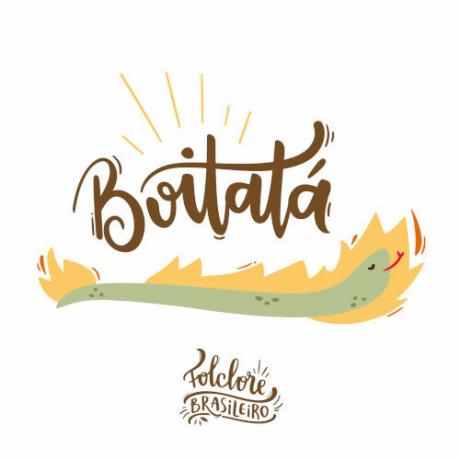O Boitatá is a being from Brazilian folklore who is described as a fire snake. Many believe that it has many eyes and its function is to protect the fields (natural lawns) from men who start fires. The first account of this legend, which was influenced by African and European culture, points to the 16th century.
Accessalso: August 22 - Folklore Day
Who was Boitatá?
The legend of Boitatá present in our folklore speaks of a fire snake that operates infield protection (natural lawns) of men who set fire to these places. Variations of the legend may also present Boitatá as a snake that has many eyes, from which fire comes out. There are also those who say that Boitatá can become a burning trunk.

That burning log would kill the person who burns down the fields. Legends say that Boitatá can chase men in its snake form, killing them out of fear or burning. THE victim is always the man who destroys fields through arson. Those who believe that the Boitatá has many eyes attribute this to the fact that this being eats the pupils of many animals.
Accessalso: Iara, the mermaid of Brazilian folklore
Where did this legend come from?
The first record of Boitatá is quite old and goes back tocentury XVI. In 1560, the Jesuit José de Anchieta reported that Brazilian natives referred to a ghost present in nature, which he called “baetata”. Anchieta's account said that the Indians believed that the Boitatá, just like the curupiras, killed the Indians.
In Anchieta's account, “Baetatá” was defined as a “fire thing”, because, in Tupi, “mbai” means thing and “tata” means fire. Many scholars point to the fact that the legend of Boitatá and its description are used as a mythologized explanation for willow fire, a fire that arises from the decomposition of organic matter.
The movements of the swamp fire made its shape resemble the movements of a snake and this fire came to be seen as a snake of fire. By a great coincidence, the word that defines snake is very similar to a thing. So, the mbai (of thing) became mob (from snake).
Therefore, in Tupi, fire snake was written as mob-tata, and the pronunciation of mob is similar to the Portuguese “boi”, which transformed the móitatá in Boitatá with the Portuguese name of the legend.
Accessalso: What it says the legend of the headless mule?
Boitatá for Brazil
The legend of Boitatá, like any other legend in Brazilian folklore, has great wealth of detailsand varies from region to region in our country. The most traditional form of the legend, as we have seen, says that the Boitatá is a fire snake that acts to protect lawns.
However, it was also mentioned that the Indians in the 16th century believed that the Boitatá pursued and killed them. In the state of Santa Catarina, there is an unusual version that presents Boitatá as a bull with a big eye on your forehead. In Rio Grande do Sul, there is a version that says that Boitatá kill animals to eat only their eyes.
It points to the existence of African culture in legend and also of European culture, for example. Many said that the Boitatá was the manifestationof thesouls of people who were not baptized in life. This is a legacy of the European belief that the wildfire was a manifestation of lost souls.
The different ways of seeing Boitatá also resulted in different names for the legend throughout Brazil. The folklorist Luís da Câmara Cascudo, for example, points out a series of other names by which this being is known in Brazil: Bitatá, Batatá, Baitatá, Biatatá, Batatão etc.|1|.
Grades
|1| CAMERA CASCUDO, Luís da. Geography of Brazilian myths. São Paulo: Global, 2012.

